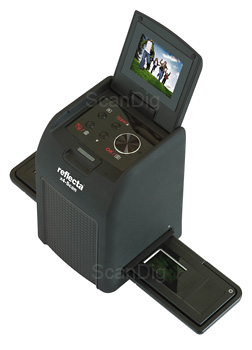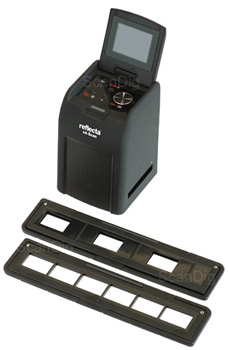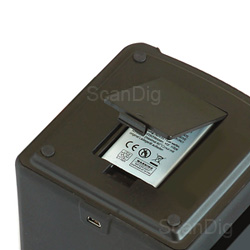Reflecta x4-Scan - Battery driven film scanner
In December 2009, just in time for the christmas trade, with the x4-Scan, Reflecta introduced another film scanner with CMOS-technology into the market. It is replacing the Reflecta X3-Scan that meanwhile is not available anymore. As it was the case of its previous model, the x4-Scan is also designed as a stand-alone-device that can be operated independently from a computer.
The Reflecta x4-scan has been replaced by its successor Reflecta x5-Scan in October 2010.
Therefore, the scanner has an integrated 2,4 inch LCD-display and a memory card slot suitable for SD- and SDHC-cards. The data are either transferred straight to the computer via USB 2.0 (not with USB 1.1), or one removes the memory card from the scanner and puts it into a card reading device. What is new in the x4-Scan is that it can be operated independently from the power supply: a lithium-ion accumulator provides the scanner with the power needed.

Within the scope of delivery of the Reflecta x4-Scan there is, beside the film holders, an adapter, and a USB-cable, the software ArcSoft MediaImpression: a media browser with which pictures and videos can be viewed and that also offers some simple image processing tools. There is the suitable software attached either for Windows as also for MacOS.
The x4-Scan uses the same film adapters as the x2-Scan, thus a slide frame adapter for up to 3 framed 35-mm slides and a film strip adapter for negative strips up to 6 images. The x4-Scan can either digitalize positives as also negatives, which means it is also possible to insert framed negatives into the slide adapter, and positive film strips or individual images (positives and negatives) can be inserted into the film strip adapter.
The use of film adapters indicates to the possibility of an automatic batch modus but unfortunately this is also not possible in the case of the x4-Scan: The slides and/or negatives have to be manually moved forward as soon as one unit is scanned. Thus, one inserts the slides or the film strips into the respective film adapter that is afterwards put into the scanner. One immediately sees the live image of the CMOS-sensor of the inserted slide and/or negative on the integrated display (if the scanner is adjusted accordingly, one also sees on the display a negative as a positive). A keystroke saves this image on the memory card within seconds. Thereafter, the film adapter is manually pushed further to the next image and, by this way, one manually scans one image after the other. Once all slides and/or negatives are digitalized in the adapter, it has to be removed and reloaded if necessary.

The maximum resolution of the x4-Scan is, according to the producer, of 1800 dpi in all scanners of the x-Scan-series. This results in an image file of approximately 5 megapixels, thus less than most of the digital cameras provide. In our detailed test report about the Reflecta x3-Scan we have shown that the actual achievable resolution is lower than it is stated on the data sheet. The x3-Scan achieved a value of approximately 1150 dpi; one can assume that the resolution of the x4-Scan is in a similar range. By scanning a 35-mm slide or a 35-mm negative with some effective 1150 dpi, the resulting image files are of approximately 1,8 megapixels. Today, such images with so few megapixels are only made by mobile cameras and very old digital cameras. Therefrom, it is assumable that the Reflecta x4Scan is also not suitable for the film archiving but at most for the digitalization for the quick viewing. Reflecta promotes this device with the feature that due to the saving on SD/SDHC cards, it is very suitable to transfer the images after the scanning to a digital frame and to view them.
But there is also not much more possible to do with the resulting quality of the x4-Scan: With the low resolution and the, compared to the previous model, also unchanged low range of density with a maximum value of 3,0, the scanner takes very few information out of the 35-mm film. Considering the 35-mm slides or 35-mm negatives that were exposed with a good camera do contain some image informaton up to 20 megapixels, one will soon recognize that with the Reflecta x4-Scan, one only takes out a fraction of all the image information that is actually contained in an image.

Thus, what is the difference between the x4-Scan and the x3-Scan? On one hand, the difference is in the already mentioned possibility to operate the scanner independently from the power supply due to its lithium ion accumulator. By this way, one can use the device with the LCD-display as a digital portable slide viewer. Moreover, the x4-Scan does not have the TV-output the previous model had - thus unfortunately, the connection to a TV for viewing the film material is not possible any more. Otherwise there are no more differences between the current device and the previous model, except the new case.
Therewith, concerning the x4-Scan we come to a similar conclusion as we did in case of the x3-Scan: those who occasionally want to digitalize some slides or negatives in the most simple way for the quick viewing and do not have any requirements concerning the image quality will be well off with the x4-Scan. Due to the saving on SD/SDHC cards, the device is well suitable for the comfortable transfer of one's images to a digital frame. But the device is not suitable for the permanent archiving of slides or negatives; therefore, a real film scanner as for example the Reflecta CrystalScan 7200 is needed.
Back to the film scanner tests index
|